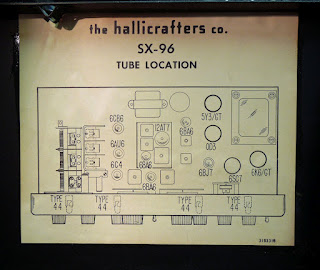I chose the SX-96 radio based upon its mechanical completeness, having no interest in eternal searches for obscure parts. One radio at the show had a twin - both needed extensive repair. It was a tempting project - I had to consider my limited work space and vetoed the idea. I wanted a radio that might become functional this year.
An Earlier Restoration...
I spent two years restoring an Atwater Kent Model 30...
...not because it was missing parts. I'll describe the odd method required to get this gem talking again in another post.
I forgot about the unsightly wire nuts... to be addressed later!
Back to the SX-96...
Since I don't have to deal with mechanical oddities, I can concentrate on the electrical aspects. Before applying power to the old beast, I will replace the electrolytic and molded-paper capacitors. Technical discussions, minutiae, and mythology regarding capacitor replacement abound on the net - it will not be dissected here. For the purists, there are modern replacements that look like the originals. I am simply using modern film caps, and putting shrink-wrap on the exposed leads. Purists will cringe... I won't worry about it.
Four molded caps and an electrolytic...
This image is near the 6K6 audio output tube. The bumble bee caps have black bodies with color stripes indicating value and tolerance. There are about 26 bees and four electrolytic caps to replace. Three electrolytics live in a large aluminum can - a multisection component that I will simply bypass with replacements underneath the chassis.
6K6 schematic - replaced caps highlighted
I'm a little ahead of the game here...
Before ordering any parts, I looked through the schematic and parts list to familiarize myself with locations. Unlike later electronics with labeled circuit boards, individual components can live in unexpected places. Usually, the location is obvious... a part that appears on the schematic originating from pin x of vacuum tube y is often soldered directly to the socket. Sometimes they can be elusive, tacked to little jumbles of parts in odd locations. There are other surprises too! Schematics may not reflect manufacturing changes, such as substitution of component values or addition or subtraction of components. Resistor values sometimes are a little different - since tolerances allow for easy substitutions. For example, I noticed a 390 ohm resistor value in place of the listed 330 value. No cause for alarm here. I also noted a few components that appeared stressed - for example, a 10K 1/2 watt resistor in the power supply filter section looked like it had been running hot - so I will add a few bits and pieces to the order.
Once I was familiar with the circuitry and layout, I scanned the parts list and simply ordered replacements for all listed capacitors, approximately 30 pieces total. I copied the schematic and parts list, highlighting planned replacements. As each part is replaced, I simply check it off on the copy. Old parts are labeled and stored until the final power up.
Next - the actual replacement fun begins.







